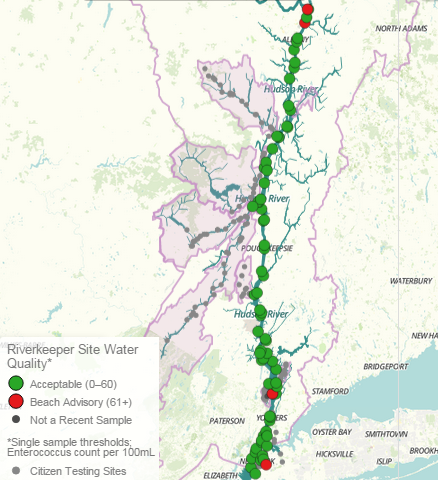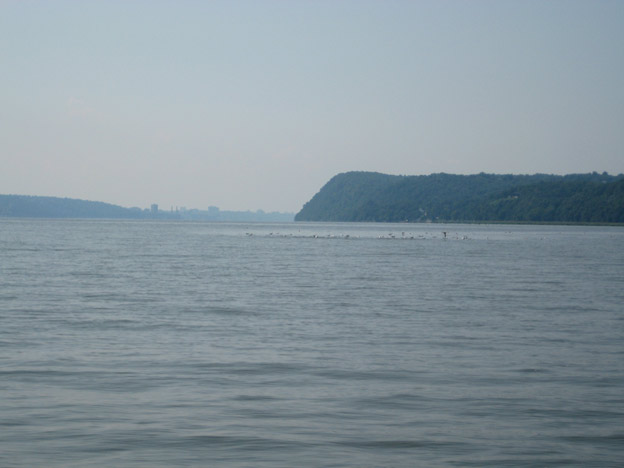|
First 2015 Water Quality Report
The first of six Hudson River Estuary water quality sampling patrols of the 2015 season is complete, and the results are posted at riverkeeper.org.
Note that the results presented here and on the Web represent a snapshot in time, and are not indicative of water quality today. We encourage the public to explore the historical data as one way to make informed choices about where and when to enter the water.
|
Hudson River Monitoring Results, May 2015

We observed excellent water quality at almost all of the 74 sites we sampled from May 11-14, which we would expect after a prolonged stretch of dry weather. The most extreme exception was at Piermont Pier, where we observed bacterial counts as high as our lab can typically count at the point where two sewage treatment plants have a combined outfall. The plants are designed to treat sewage, so we should expect water free of fecal bacteria coming from this combined outfall. So we asked the Department of Environmental Conservation to investigate.
Following sampling, inquiries to the sewer plants and permit reviews, the DEC was able to explain the high counts. We sampled on May 12, just three days before South Rockland Sewer District #1 is required to begin seasonal disinfection of its effluent. (The Orangetown sewage treatment plant, which discharges at the same point, is required to start disinfecting May 1, while the effluent from Westchester County’s plant in nearby Yonkers must be disinfected year-round.) Sewage goes through multiple stages of treatment, with disinfection typically the final step.
 |
| The sewer districts serving several towns in Southeastern Rockland County are permitted to discharge up to 48.9 million gallons of treated sewage per day from a combined outfall near Piermont Pier. As we learned, “treated” means different things at different times of the year. The only visible sign of this discharge is often nothing more than a glassy sheen as can be seen in this photo courtesy of Laurie Seeman. |
Without disinfection potentially harmful microbes are discharged to the water. Because many municipal plants in the Hudson River watershed are required to disinfect their effluent only during the recreational season, the bacterial counts we observed are probably typical of many Winter and Spring discharges throughout the watershed, as well as year-round discharges from a handful of municipal sewage plants and many smaller non-municipal plants that aren’t now required to disinfect at all. Riverkeeper advocates for disinfection at more plants, using UV light, which kills microbes without using chlorine that can poison fish habitat if not properly used.
The good news? Disinfection is a reality now at plants discharging to the Albany Pool, with the completion of major work in the first year of a 15-year Long Term Control Plan for reducing combined sewer overflows in six Capital District communities. The data that we and the communities gather will tell us how much of an impact this important infrastructure investment negotiated by the Department of Environmental Conservation has on water quality in this long-suffering stretch of the river.
Stay tuned soon for the results of the first round of community sampling events on Hudson River tributaries and New York City-area public water access points. Data for the Sparkill Creek and Pocantico River are already available at Riverkeeper.org.
|

EVENTS
WDST Radio Interview About Hudson River Tributaries
Monday June 1, 8-9 AM
On Air - WDST
Health of the Hudson - A Panel Discussion
Thursday June 4, 6:30-8:30 PM
New York, NY
Wallkill River Watershed Citizens Group Meeting
Thursday June 4, 7-9 PM
New Paltz, NY
Citizen 'Boat Brigade' Patrol of the Wallkill River
Saturday June 6, 9AM-12 PM
Wallkill, NY
NEWS
How to report an oil sheen on the Hudson River
- Boat Blog
Margo Pellegrino: View from the water
- Boat Blog
Why did the squirrel swim cross the river?
- Boat Blog
Scenes from first Hudson River patrol of 2015 #followtheboat
- Boat Blog
|
Generous funding for Riverkeeper’s Water Quality Program, has come from many sources, including from our partners at CUNY Queens College and Lamont-Doherty Earth Observatory of Columbia University; and, the Austen-Stokes Ancient Americas Foundation, Chris and Suzanne Augustin, Dale and Laura Kutnick, Dextra Baldwin McGonagle Foundation, Double R Foundation, Eppley Foundation for Research, HSBC Water Programme, Hudson River Foundation for Science and Environmental Research, John McLaughlin, Michele Hertz and Larry Friedman, The Nancy and Edwin Marks Family Foundation, New England Interstate Water Pollution Control Commission (NEIWPCC), S. Mackintosh Pulsifer, Mike Richter, Sun Hill Foundation and the Wallace Research Foundation, and many Riverkeeper members.
The contents of this report do not necessarily reflect the views and policies of NEIWPCC or any other funder, nor does the mention of trade names or commercial products constitute endorsement or recommendation for use.
|
